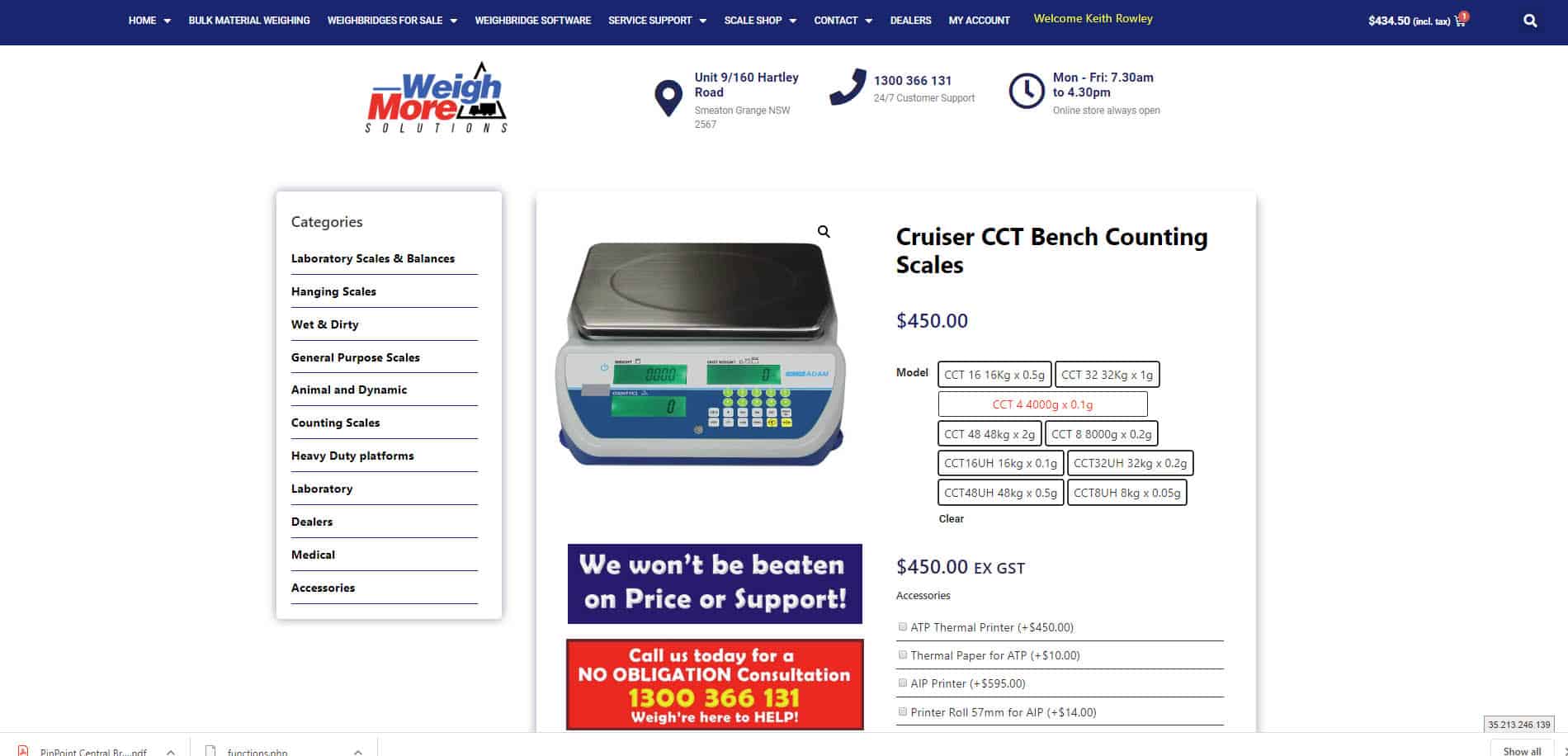eCommerce Solution – Developing a Online Shop for Weigh-More of Smeaton Grange Sydney NSW
eCommerce Solution - Online Shop Development - for Sydney Company Weigh-More
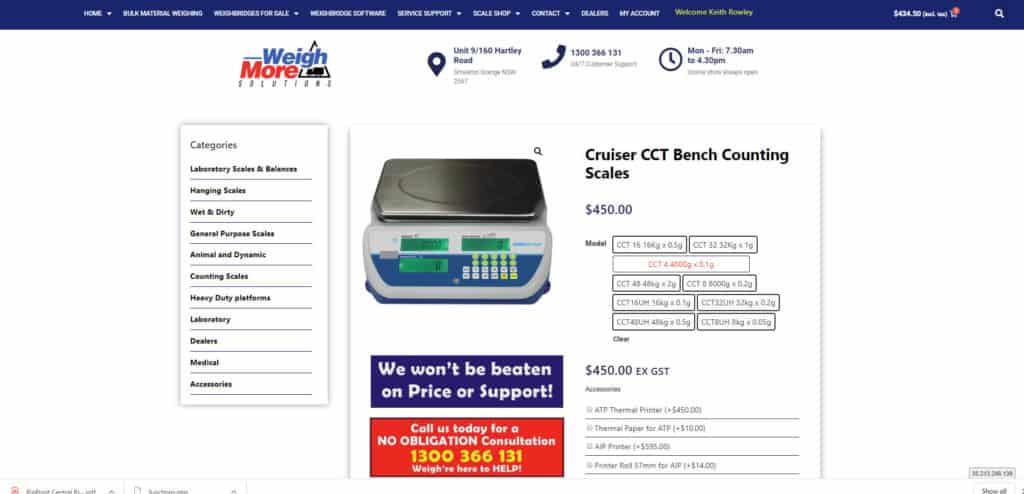
eCommerce Solution - A SINGLE PRODUCT PAGE from WEIGH-MORE
eCommerce Solution - eCommerce Website Development - a Live Case Study at Sydney Business Web
This article is a case study on development of an eCommerce Solution - Online Shop for an established and successful company, Weigh-More Solutions. The article illustrates some of the engineering methods I have learned over the course of my engineering and and business careers. This is how we develop eCommerce Solutions at Sydney Business Web.
The Essence of an eCommerce Solution - Developing an Online Shop for a Technology Products Supplier
We were very excited when we won the business to build a new eCommerce solution / website for Sydney company Weigh-More which is a highly respected seller and developer of weighing products. Having spent much of my life as a design engineer, it was great being back in touch with electronic technology and processes - Weigh-More are true professionals.
Benefits of Doing the Systems Work Up Front
Negotiating a business website development contract requires mature judgement because the market has been muddied by low price operators with cookie-cutter designs and very little business or technology experience. This always results in missing functions and / or cost escalation for the unfortunate buyer.
Thus, a truly professional approach to an eCommerce Solution requires a systems approach - because an eCommerce website is a system for generating revenue when all is said and done. We break this down into steps as shown below.
The Top-Down Design Process for an eCommerce Website
Defining products is part of a Systems Engineering process. This is what we did for the Weigh-More Systems account:
- Consult with Weigh-More management about what the business needs online - what is the vision for the website and what functions must it fulfill?
- Write a User Requirements Specification for the eCommerce Solution based on the discussion.
- Turn that user User Requirement into a Technical Specification. This is where we decide which website technologies to use, how to best host the website, determine security, payment gateways, membership systems etc.
- Write an (developer) test document for the eCommerce website
- Develop the eCommerce website
- Test the eCommerce website and fix any problems
- Hand the eCommerce website over to the customer and on acceptance, start the 90 day warranty against defect.
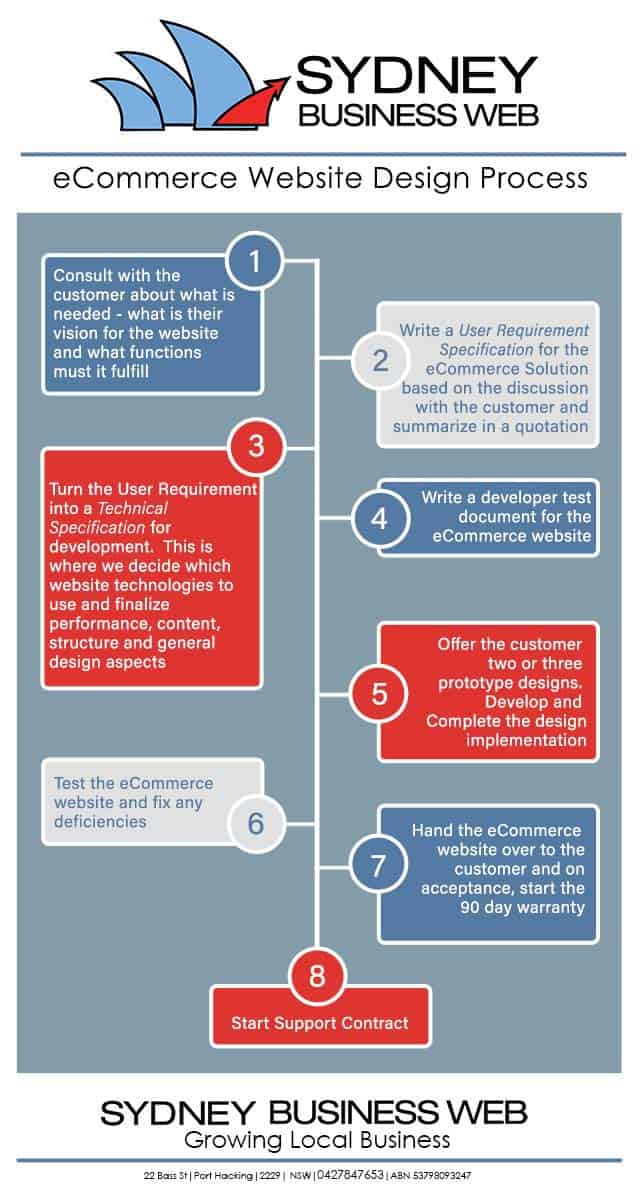
eCommerce Website Solution Development Flow
Everything Starts with the Customer Requirement and the Business Requirement
The Business Requirement for the Weigh-More eCommerce Website
The business requirement we define as "designing around who the business needs to reach and address" and it has a significant impact on the design of our websites.
We work on the business requirement up-front as an element of customer requirement - it is an integral part of the Customer Requirement, but needs to be stated clearly as a component because its impact can be heavy due to the different requirements of SEO structure for reaching various audiences.
For instance, a purely local business needs to appear in search engines in a way specifically designed to take advantage of Google's process in local mobile and desktop searches. An eCommerce solution trying to reach a national or international audience requires a different design and different content.
Weigh-More needs both of these options and the managers responsible knew exactly what was needed.
The B2C Weigh-More eCommerce Website Requirement
Weigh-More needs to reach householders and individual buyers in the retail, medical, veterinary practice, restaurant businesses and many more,. This is a national and local requirement and requires Weigh-More to appear in specified regions of Australia as a local company.
The B2B Weigh-More eCommerce Website Requirement
Weigh-More needs to reach the B2B transport sector where advanced weighbridges and weighbridge software and technology are in demand to support trade and transport infrastructure. This is also a national and local requirement and requires Weigh-More to appear as experts in their subject matter on the search engine - which s quite different to the local SEO needs of a small business.
Two SEO Strategies are Needed Running Side by Side
To achieve the required reach and appearance in the search engines, we recognize that these are separate audiences and sub-audiences, each requiring its own website-SEO and off-site SEO Strategy
Up until this time, weigh-More had invested in some content, which we recovered to maintain its SEO value and to preserve stability in the search engines' assessment of the company's website. We added decent images and installed a on-site SEO optimizer so that we can optimize all the meta data when we have completed SEO analysis.
The blog page matrix below is part of the effort needed for Weigh-More's national reach as experts in the domain of weight - measurement.
For National reach: The Weigh-More 'Experts Blog'
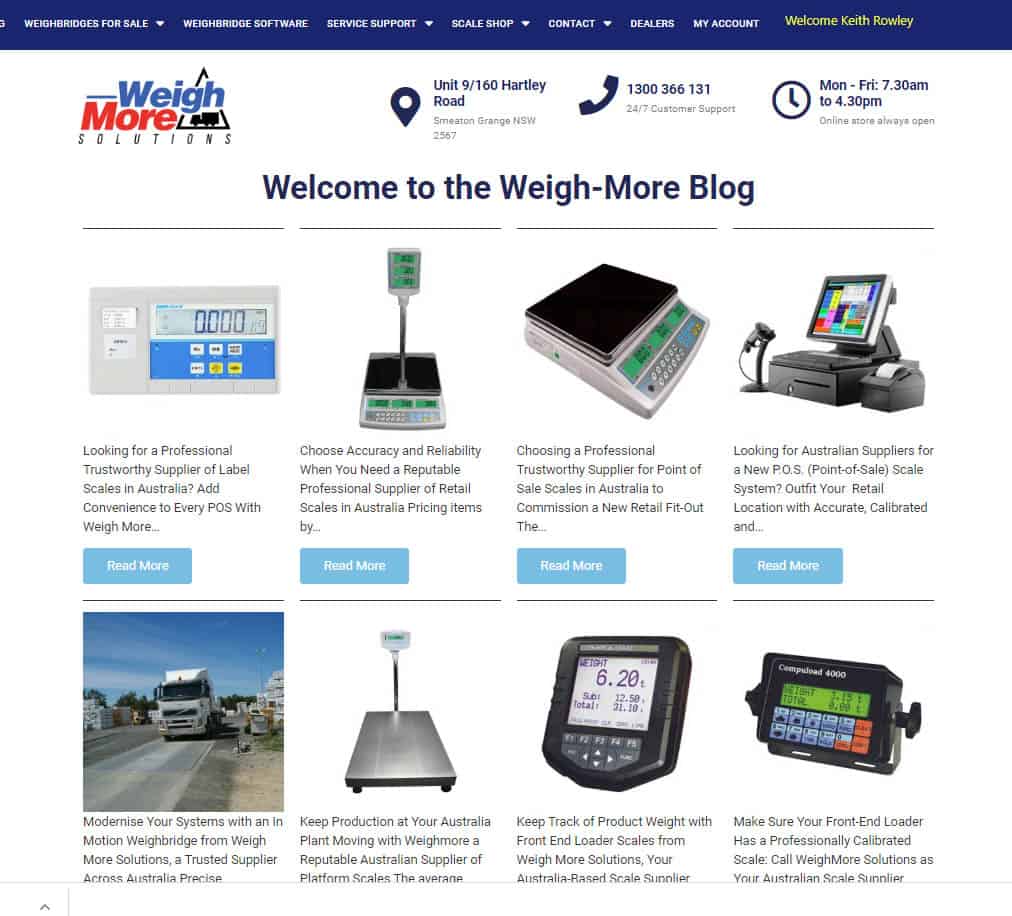
eCOMMERCE WEBSITE - THE WEIGH MORE BLOGS FOR SEO
National reach is achieved in two ways:
1) Establishment of web pages for each specific region. This is what we have done for own website.
2) Establishment of a 'center of expertise' area on the website with blog posts rich in keywords for the business' area of expertise. Over time, such articles can bring buyers to your business website globally regardless of your location.
As an example, several years ago, we were promoting the sale of Essential oils in the United States. We published a post called 'Essential Oils for Autoimmune disease' and pushed it to the top of Google. It brought in many sales that we could not have made without a large ad-spend. Even today, that article appears on page 1 of Google in the US - 4 years and more later!
For Local Reach: General eCommerce Website Structure
We have written about this in some detail here but here are the key points for this article:
- When a local customer searches for something you sell, your website (if it appears at the top of the search), must allow instant click-through for telephone, email and location. This is critical for local companies such as electricians and restaurants, but less so for a company like Weigh-More whose buyers are far less likely to make instant decisions.
- A local business website should have a Google Map for easy navigation to its premises (if you are a 'bricks' operation)
- Every local business in the B2C space should have prominent testimonials on its landing page and/or product reviews. In the B2B marketplace, a technical specification is more important. Thus, almost all the Weigh-More products have downloadable specification sheets.
- Many local business websites such as restaurants should preferably have a voice-search facility. Saying 'hamburgers' into a website search on a phone and going straight to the product page is a huge advantage that not many businesses yet take advantage of. We have illustrated the very effective text search we installed
Local searches are made primarily on mobile devices, and customers often need something in a hurry, be it a plumber, an electrician or a sandwich. You get one chance to impress in about one second - and then it's over one way or the other. Whilst we have kept Weigh-More's phone contact at the top of the page on mobile, we are less concerned than we would be for a small vendor such as a plumber or doctor.
Key points from the Weigh-More eCommerce website user Requirement
We sat with Weigh-More management and discussed the possibilities for their new eCommerce website. In this case, our customer was very well informed and knew exactly what they wanted,
- 1Smooth user experience flow from product selection to payment
- 2Optimized loading speed on mobile and desktop
- 3Easy to select and pay for products and add-ons and accessories
- 4Easy upload of new products
- 5SEO optimized blogs using existing content
- 6Preservation of existing SEO value for national reach
- 7Credit card and PayPal payment facilities
- 8A Dealers membership facility with a range or products and prices for dealers only.
- 9Personal customer accounts online
- 10Email notifications to the business and to customers for each purchase
- 11Product shipping calculator and interface to freight companies
- 12Option for site visitors to download product specification documents for any product
- 13Products divided into categories
- 14Website color scheme to be concordant with the Weigh-More logo and corporate identity
- 15Website hosting in Australia and 24x7 hosting support
- 16Support contract availability
- 17Social media interface (Facebook)
- 18Clickable phone and email links
- 19Mobile adapted and the facility to switch off some elements on mobile for speed and appearance.
- 20Daily backup
- 21Secure website with security features and scanning / anti malware protection
- 22Customer review features for products
- 23Contact forms at specified places
Notice that the above requirements state 'WHAT' the customer wants - not 'how' It is the job of the systems engineer or systems designer to turn that 'what' into the 'how' by writing a eCommerce Solution Functional Requirement.
Deriving the eCommerce Solution Functional Specification from the Customer Requirement
The eCommerce Solution Functional Specification is the next step after writing the Customer Requirement Specification. The Customer Requirement specifies 'what we want it to do, how we want it to look, whereas the functional requirement formalizes this into 'we will accept payments with (technology), we will install a membership system for the dealer functions, we will have a one-click payment system, and so on.
It's usually the case that customers looking for a business website, do know what they want, but sometimes they do not to know what's possible within their budget and sometimes,t they do not know how to ask for it. This is actually totally unnecessary situation. A good eCommerce website developer should always be able to converse in straightforward non-technical language and turn that discussion into a eCommerce website requirements document that both customer and developer are comfortable with as the basis of a development contract.
In military development where I worked for many years , all specifications were very complex and expensive to develop. We never use the full process in commercial products because it would cause a huge price escalation. But a user requirements specification, no matter how simplified is absolutely essential to the development of an eCommerce Website as a technical specification to translate what the user wants into a technical specification.
Writing the Technical Specification for an eCommerce Website
In this specification we have to decide, on the basis of the customer requirement, how the website will be implemented. In this article, we cannot discuss the implementation for WEIGH-MORE because that is confidential, but we can describe the process.
Step 1: Define Maximim Loading Speed
Decide on maximum loading speed for every website page. This will determine many aspects of site implementation such a whether videos can be included, hosting quality, number of images, which CMS etc. (We don't ever recommend writing in basic HTML, JS, CSS as development time would be too long and the expense of design and support would be prohibitive).
We build most websites with WordPress, but if we could see that we could not meet a customer's needs with this CMS then we would either use another technology or refer the customer to a suitable supplier.
Please see our extensive note below on website speed as approached for Weigh-More Solutions.
Define Every Contributing Technology and Plugin
This is quite a task. For instance, what is the best technology /software / plugin to provide shipping calculation, dealer-only prices, product upload, payment gateway and so on. These solutions have to be matched for compatibility with all the other technologies on the site. We go through every user function and allocate it to a software module or plugin.
Define the Maintainability of the Website
eCommerce websites require regular updating with products, prices and content. This always means that a Content Management System must be used - updating and adding code is really not an option because it requires technical skills, it's slow and it's expensive.
When Weigh-More specified that the site must be easily maintainable, this was a determining factor in the selection of a Content Management Sydtem for their new eCommerce website.
Define the Visitor Search and Buy Flow of the Website (Ui and Ux)
When a visitor finds Weigh-More. we need to make the journey from finding the right product through to purchase pleasurable, quick and interesting.
We achieved this by:
- Using the product and category topology given to us by Weigh-More
- Using a search facility. We did not deem a voice-search to be an advantage on this website but it was considered. Instead we used a superbly clear and easy to use text search:
Search facility on Weigh-More
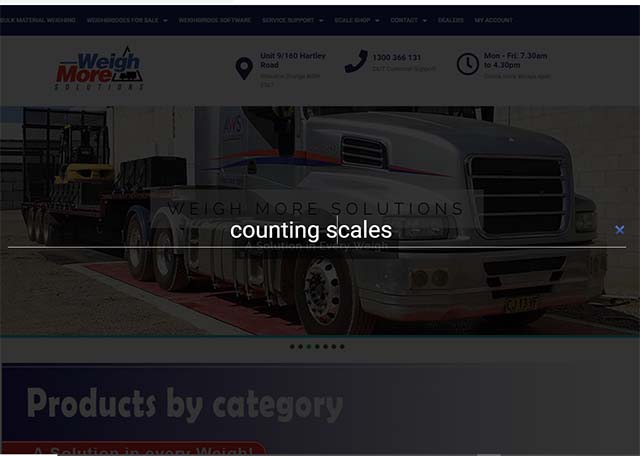
Search screenshot on Weigh-More eCommerce Website with visitor query
Search Result on Weigh-More
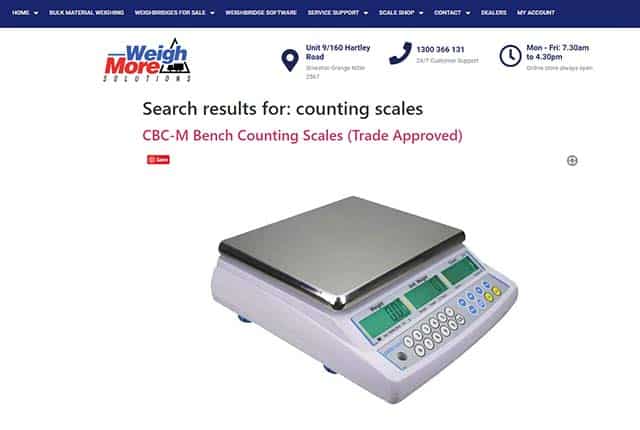
search result on eCommerce Website Weigh-More
3. We allocate the 'Buy' Buttons for the fastest possible customer journey.
4. We place 'confidence' symbols strategically to reassure the buyer (see below)
5. We design-in good website speed (see guidelines below)
Define Website Security According to Best Practice and Customer Requirements
An eCommerce website must have security or it simply will not be permitted to operate interfaces to payment channels - that's why our websites have an SSL (Secure Socket Layer) certificate. But we needed more than that for Weigh-More, so in addition, included additional protection against hacking, brute force attacks and malicious log-ins. In addition, we added daily malware scans at the host as well as daily backups.
An eCommerce solution, professionally implemented, creates a revenue stream for business and any down-time is simply unacceptable because it costs money.
Note on Confidentiality
As a matter of course, in the interests of our clients in a competitive environment, we have started using measure to hide the technical data underlying the design from 'snoop tools'. In addition to confidentiality, this also provides some protection against hackers. Nothing is ever foolproof in software, but every designer should take protective measures. For Weigh-More, we adopted security measures on the server as well as on the website.
Define Pages and Content and Products for Your Online Business Website and build!
Once all of the technology issues were defined and settled, we began to build the new website, using the old website in place until we were finished.
Test and Handover the Website to the Customer
A Website is like any other piece of software and must be tested thoroughly before it is released. Bugs and minor irritations are inevitable, but a solid test regime will sort most of them out. A test document is important - it is based on the user requirement and so not too onerous to write but still very important. And finally - turn the key and handover to your customer and start the warranty clock.
If he/she wants to do his/her own maintenance and updates then a training session will be needed. It's far preferable for all concerned though for them to have a support contract in place. this allows the customer to focus on his/her business and the developer to have a reasonable revenue stream for long-term support - everyone's happy.
Notes: Critical Website Performance Parameters
Note 1: Page Loading Speed
We won't write a screed on this (you can find more details here) - everyone knows that website speed is very important, indeed critical. There are several factors contributing to acceptable website speed. the key ones are:
- Images - how big they are, how many there are and how well optimized they are
- The total size of page content
- The speed and capacity of the hosting server
- The use of compression on the eCommerce website
- The use of a cache on the eCommerce website
- The use of a Content Data network (sometimes)
- Minimizing the appearance of unused code on a page
- Minimizing the number of calls a browser must make to your website server.
- Compression and combination of code blocks on the eCommerce website
Website Loading Speed is Nor Always What it Seems
A good deal of caution is needed when discussing website speed. Why? Because owners of small and medium businesses must operate on the basis of 'what's good enough?' For large scale operators, a tenth of a second may be a lot because there are thousands of people making purchasing decisions at any given moment. For a smaller company, spending $20,000 on saving half a second will probably not reap a worthwhile return.
Our experience shows us that as long as a website page is viewable inside 2s - 4s, that's good enough for the vast majority of visitors. There may still be scripts to load and external resources to fetch, but usually, this will not matter to the visitor because as far as he/she is concerned, the page has loaded already.
Finally - even the big websites often do not load so fast! See the real-world measurements below.
Website Speed Measurements
Below, you can see two page speed measurements for a single product. the first is a scale on Weigh-More's website and the second is a scale on Amazon.com.
*Technical note: The Weigh More measurement was made using a Sydney server and the Amazon measurement was made using a US server, so that the measurement is fair. Both measurements were made twice.
Weigh-More product Page loading vs Amazon
Weigh-More Product Loads in 3.1s
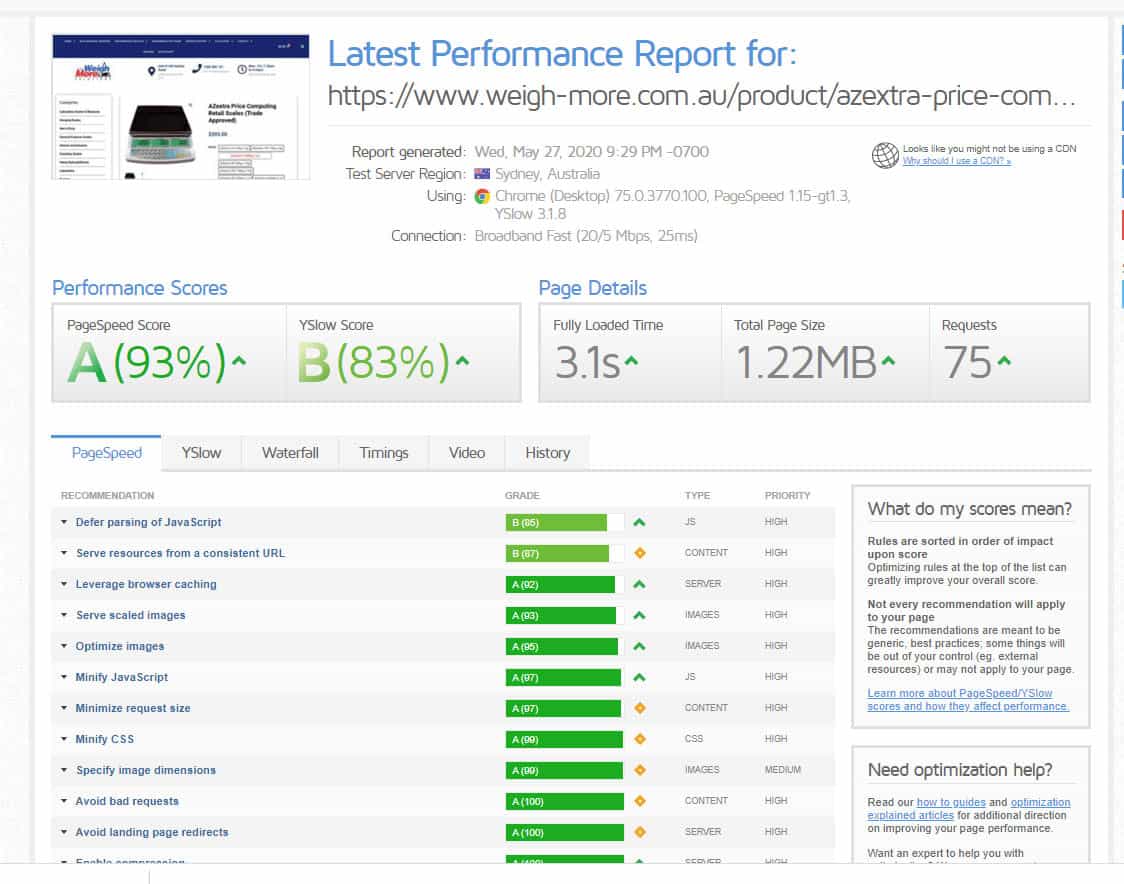
eCommerce website
Amazon product loads in 13.3s
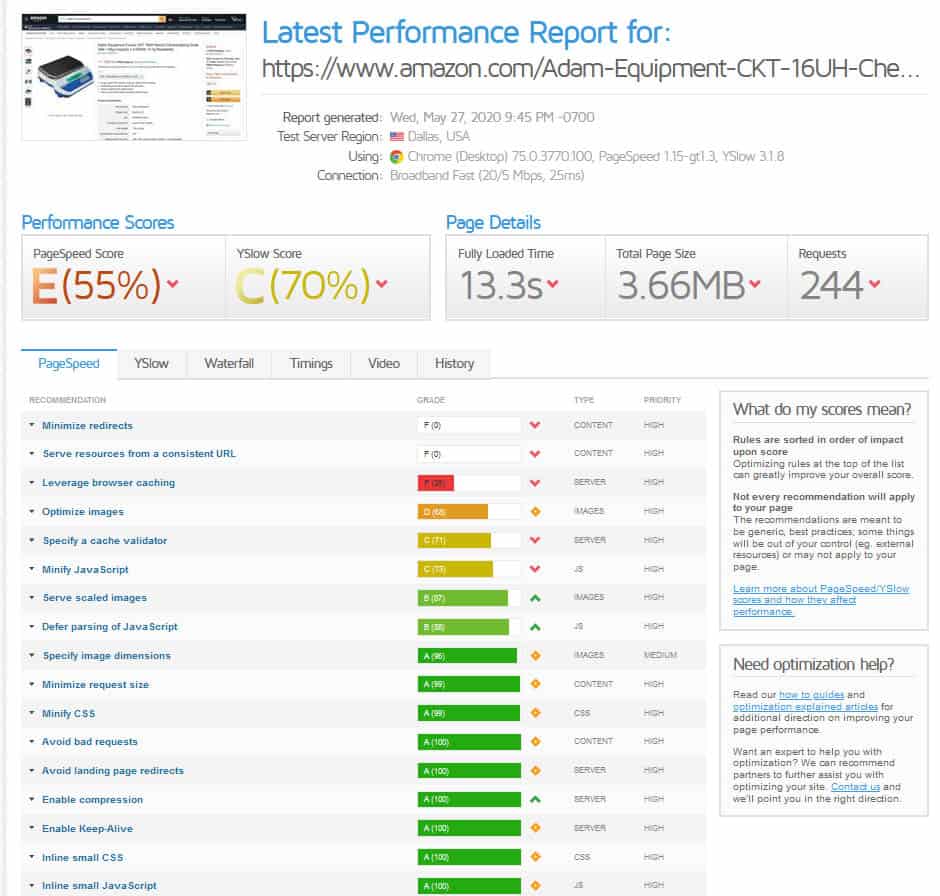
eCommerce website
As far as the visitor is concerned, both websites look a lot faster than the numbers show, because these measurements give final load times that are based on complete loading and 'ready for action'.
In fact, if we strip away the geek-speak, what we want is an eCommerce Solution page that visibly loads within 2s and is ready for action within around 6s - because that's really around the shortest time for most people to want to press a 'buy' button. There are technical terms for the various phases of page-loading - but who cares? Open your browser and check it out.
As a general rule, we make our product pages fully visible inside 2s and fully loaded, ready to rock inside 6s. Amazon don't seem to suffer from being a lot slower!
eBay Speed Performance
eBay is a fascinating study in speed eCommerce Solution performance that supports our viewpoint. The site loads visually very, very quickly, but scripts are still being loaded once the page looks visually great - but the speed performance measurement is superficially very poor.
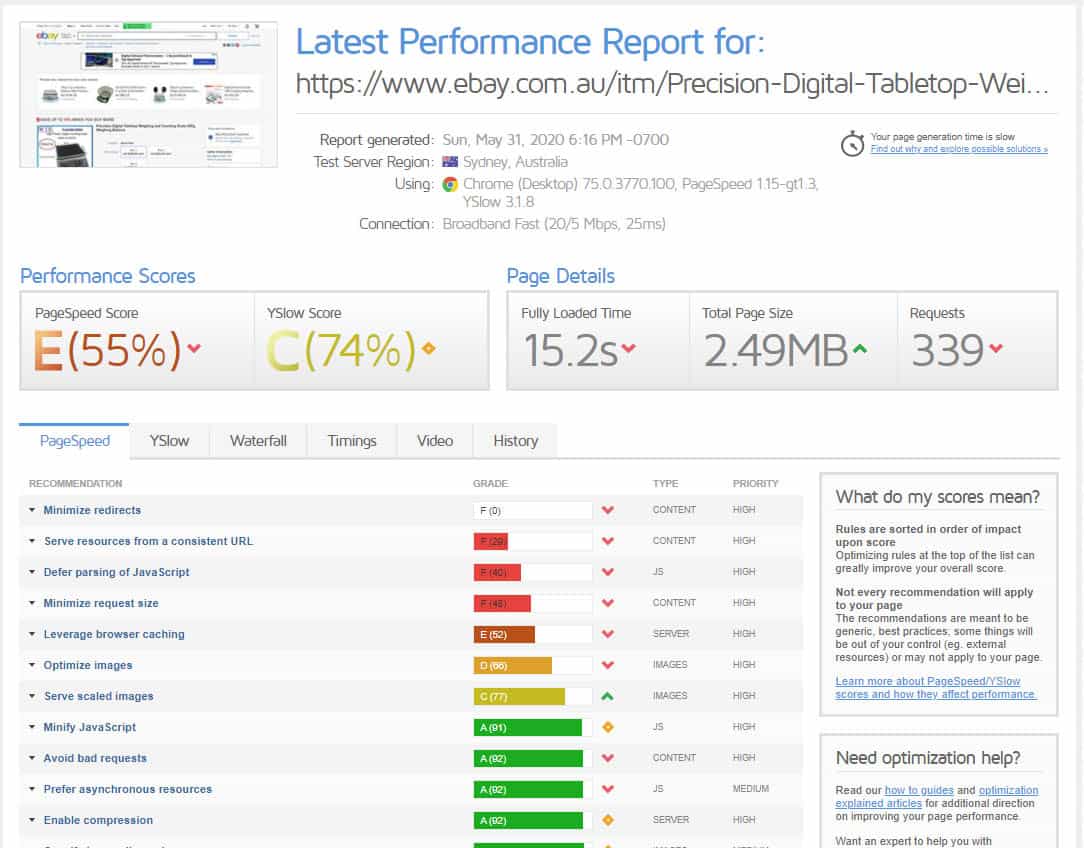
eCommerce Website Speed - eBay page - Loads visually fast but measurement says poor
Note 2: eCommerce Solutions - Gaining Trust on the Weigh-More Website
Weigh-More is a highly reputable company with an exemplary record of fair and ethical dealing. Like every business though, it has to gain confidence online before people will type in their credit card details. The best way to do this is to use trusted payment methods and to make the customer very aware of the security employed on the website.
We did this by:
- Installing a Secure Socket Layer Certificate on the site.
- Installing PayPal which is universally trusted
- Installing images of the credit cards accepted
The website NEVER HOLDS CREDIT CARD DETAILS. and NEVER has access to them. All of the financial data entered by a customer is encrypted and transmitted to the financial institutions concerned.
Communicating with Customers / Buyers
Customers who have paid for a product on an eCommerce Website require immediate notification of their purchase and the vendor also requires notification automatically. We installed an eCommerce Solution that achieves this. There is potential for further augmentation of this facility as may be required.
Note 3: Confidential Dealer pricing in an eCommerce Solution Business Website
Many B2B businesses who also serve the B2C markets need to keep their product dealer prices confidential. We achieved this for Weigh-More with a eCommerce Website membership system that allows them to vet all applications for membership and then grant login rights.
The membership area for dealers records their purchases and account details. Having a membership list also allows Weigh-More to keep their dealers and customers aware of the latest developments and products in the highly technological area of weight measurement.
Note 4: Downloading Product Data Sheets on an eCommerce Website
For technical products, this is a must-have feature. Most of the Weigh-More products have once-click downloadable PDF sheets to help customers. This could also be made subject to a membership login should that be required.
Thank you for visiting us - we hope you found our article useful.
CONTACT SYDNEY BUSINESS WEB NOW!
get started online NOW with your ONLINE BUSINESS ENGINEERING




